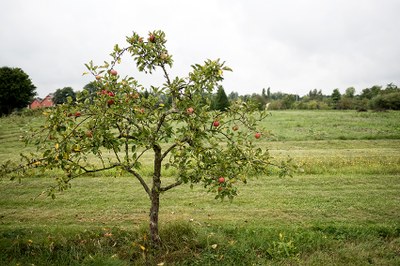Warmer Winters Increase the Risk of Frost Damage in German Apple Cultivation

Apple tree. Photo: Matthias Heyde
Climate change affects the growing seasons in German apple cultivation with in part unexpected consequences. This has been demonstrated by a research team of Humboldt-Universität zu Berlin (HU) and Climate Analytics. ‘We already see that apple trees today often blossom earlier than they did even twenty years ago. In this way frost damage after flowering can occur more frequently, even though the number of frost days overall has decreased with global warming’, explains Peter Pfleiderer, the main author of the study. These kinds of risks will increase in the future, according to this scientific investigation, which was published in the journal Climatic Change.
Growing regions on Lake Constance and in the Altes Land are especially affected
In order to be able to assess the probability of frost damage in relation to global warming, the author team compared three climate scenarios: the actual climate from 2006-2015 with global warming of already one degree in comparison to pre-industrial levels as well as two potential future scenarios with temperature increases of 1.5 degrees and 2 degrees. The results were that in the north as well as in the south of Germany the probability of frost damage increases significantly with continuing climate change, while no clear trend is identifiable for Central Germany. Apple growing regions on Lake Constance and in the Altes Land are especially affected. ‘In northern Germany the probability of years with frost damage is about eight per cent higher in a two-degree world than under current global warming’, explains climate physicist Pfleiderer, who is a doctoral candidate at the Integrative Research Institute on Transformations of Human-Environment Systems (IRI THESys) at HU and also a research analyst with Climate Analytics Berlin.
For the present study, a large number of climate simulations were used for the first time to investigate the probability of frost days after the beginning of flowering. The beginning of flowering depends on the weather conditions of the previous winter and was estimated in the simulations with the help of phenological models. ‘In the study we were able to specifically analyse the beginning of flowering as well as the last frost days for each year, which allowed detailed statements about frost risks,’ explains co-author Inga Menke from Climate Analytics.
Achieving the Paris climate goals clearly reduces risks for apple cultivation
‘Practical adaptive strategies for frost damage are well-known. For example, using more robust apple varieties or sprinkling apple plantations with water prior to frost can protect the blossoms from freezing. Such measures, however, are always tied to higher costs and are also dependent on sufficient water availability. Our results show clearly that only by achieving the Paris climate goals can the risks be reduced in a sustained manner,’ says Carl-Friedrich Schleussner, also a co-author of the study.
Frost damage, however, is not the only risk for future apple harvests. A lack of cool winter days could also mean that flowering does not even occur in certain regions – a concern that is already being discussed in Italy and could become a real problem in the south of Germany. If global warming is not limited to a safe level, then apple cultivation will be almost impossible in parts of Germany at least with traditional varieties of apples.
Publication
Peter Pfleiderer, Inga Menke, Carl-Friedrich Schleussner (2019): Increasing risks of apple tree frost damage under climate change. Climatic Change
DOI: https://doi.org/10.1007/s10584-019-02570-y
Further informations
Contact
Peter Pfleiderer
IRI THESys
Humboldt-Universität zu Berlin
Phone: +49 30 2093-66378
pfleidep@hu-berlin.de
